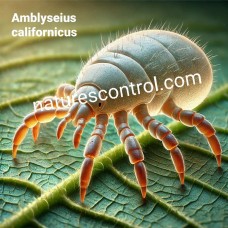Pest: Thrips

First Sign: Leaf surfaces finely speckled with yellow spots. Later, a silvery metallic looking sheen may cover leaf surfaces. Not all Thrips create this sheen. With or without the sheen, you'll also see black specks (Thrip fecal material). Only on close inspection is the pest itself found. About 1/16" long, thrips can move quite quickly for their size. Many gardeners report thrips as a small "worm with legs". Larvae and adults look similar, but adults have wings and can fly.
Hundreds of Varieties, Many Colors: Too many to try and describe here, but they all feed the same way - by scraping and rasping at tender leaf surfaces. For control purposes, the main difference is where they pupate as youngsters.
Special Species Notes: Most Thrips move down into soil, rockwool or other synthetic growing media to pupate. This is the first stage at which to control Thrip populations, using Predator Nematodes. Often after two months, regular application of Nematodes alone gives good control. However, for heavy or persistent infestations, we recommend using Nematodes in conjunction with above-ground controls. Your choice will depend largely on the environment in your growing area. Please see Pirate Bugs and Sticky Blue Traps.
Handy Hint: Soapy water sprays (such as Safers Soap) don't continue to kill off insects after the initial spraying, so they're safe to use before you add Hired Bugs. Use them instead of more powerful, longer lasting pesticides, but test a few leaves first for any adverse reactions. And, if you use soap on produce, make sure it can be washed off to avoid any soapy taste.
Predator Nematode "Double-Death" Mix!
Our popular mix of two Predator Nematodes species to cover a wider range of soil depth preference.
Steinernema Species
Top 3 to 6 Inches of Soil Media:
Heterorhabditis Species
"Double-Death" Predator Nematodes are some of the most useful pest controls to come along in years. They attack and kill more than 250 different insects, including Fleas, Thrips, Fungus Gnats, even insects as large as Cutworms! Nearly any insect that spends a part of its lifecycle in the soil is likely prey for "Double-Death" Predator Nematodes.
Application: "Double-Death" Predator Nematodes come packaged on a small piece of synthetic sponge that you rinse out in water. Then use any type of watering can or sprayer to apply them to the soil. The pressure of passing through a sprayer nozzle won't faze them in the slightest. Each package of one million "Double-Death" Predatory Nematodes treats up to 2,500 square feet of soil surface. For best results make repeat applications every 4-6 weeks throughout the season when soil temperatures are between 50° F. & 85° F. and target pests are present.
Thrips Predator Mites
Normally, Thrips Predator Mites (Amblyseius cucumeris) are most effective under conditions of 70-85% humidity, against all species of Thrips. They will also eat an occasional Spider Mite, and other small pests. However, reports have been poor in low humidity environments, so use these predators in greenhouse and other interior locations with high humidity levels only.
Application: Simply sprinkle your Thrips Predator Mites onto plant foliage or on rockwool blocks in infested areas; they'll do the rest. Use 100-500 per plant; or 200,000 per acre, repeated every 2-3 weeks until established.
Handy Hint: Insect screening material can be stretched over air intakes to filter many pests out, but you may need larger exhaust fans because of the air restriction. Check with your greenhouse or nursery supplier.
"Triple Threat" Spider Mite Predators
Introducing the Ultimate Pest Control Trio: Phytoseiulus persimilis, Neoseiulus californicus, and Am..
Amblyseius andersoni (Typhlodromus (Amblyseius) potentillae and Amblyseius (Euseius) andersoni)
Amblyseius andersoni (Typhlodromus (Amblyseius) potentillae & Amblyseius (Euseius) anderson..
Amblyseius californicus
Amblyseius californicus (Western predatory mite or the Californian predatory mite): Nature's Solutio..
Amblyseius swirskii
Amblyseius swirskii (controls Spider Mites, Russet Mites, Broad Mites, Thrips, and Whitefl..
Anystis baccarum (Crazee Mite) Units of 1000
Introducing Anystis baccarum (Crazee Mite) - Your Ultimate Biological Pest Control Solution &nb..
Anystis baccarum (Crazee Mite) Units of 250
Introducing Anystis baccarum (Crazee Mite) - Your Ultimate Biological Pest Control Solution &nb..
Anystis baccarum (Crazee Mite) Units of 50
Introducing Anystis baccarum (Crazee Mite) - Your Ultimate Biological Pest Control Solution &nb..
Mammoth Canncontrol
Mammoth Canncontrol is lab and greenhouse tested – proven to eliminate powdery mildew, botrytis..
Ladybugs (Hippodamia convergens)
Ladybugs: Natural and Most Effective Aphid Control Solution Nature's Control is your trusted source..
Pirate Bugs (Orius insidiosis)
Minute Pirate Bugs (Orius insidiosis): Mainly for use against Thrips, Aphids&nb..
Fungus Gnat Predators (Hypoaspis miles also known as Stratiolaelaps scimitus)
Fungus Gnat Control: Fungus Gnat Predators Use Fungus G..
Green Lacewing Larvae Eggs (Chrysoperla carnea) Eggs on Cards
Green Lacewing Larvae Eggs: For use against Aphids, Thrips, Mealybugs ..
Green Lacewing Larvae (Chrysoperla carnea) "Ready to Go" Larvae
Green Lacewing Larvae "Ready to Go" Larvae: For use against Aphids, Thrips..
Predatory Nematode Double Death Mix (1 Acre Coverage)
Most Effective Control For Soil Dwelling Pests: Predator Nematode "Double-Death" Mix..
Predatory Nematode Double Death Mix (1/4 Acre Coverage)
Most Effective Control For Soil Dwelling Pests: Predator Nematode "Double-Death" Mix..










-228x228.jpg)

